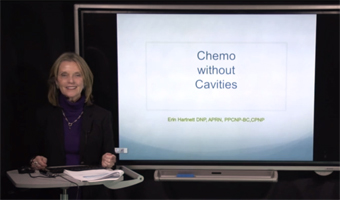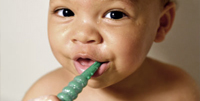Oral Health Literacy
- Education
- Smiles for Life
- National League for Nursing
- Chemo Without Cavities
- Babying Our Babies
- Transforming Whole Person Care Symposium
- Interprofessional Education Guides
OHNEP INTERPROFESSIONAL ORAL HEALTH EDUCATION
OHNEP has created several quality, effective, and successful interprofessional educational tools that we recommend you use to expand your oral health care skills and incorporate them into your professional practice. These include our faculty tool kits, case studies, and oral health literacy, as well as our collaborations with the National League for Nursing (NLN) and Smiles for Life.
These free and flexible learning tools are designed for a variety of health care settings. Since OHNEP began in 2011, educational modules like these—studied by nurses, nurse practitioners, midwives, physicians, dentists and other health professionals—have led to the launch of more than 300 interprofessional projects to improve oral health in communities across the US, with more underway.
SMILES FOR LIFE: A NATIONAL ORAL HEALTH CURRICULUM
Smiles for Life consists of eight online curricular modules to be completed by students, faculty and practitioners. Each comprehensive module has an interprofessional focus on how primary care clinicians can enhance their role in the oral health of their patients across all age groups. Each can be tailored for specific clinical or teaching needs. Learn more about Smiles for Life and complete the modules at the following link: smilesforlifeoralhealth.org
NATIONAL LEAGUE FOR NURSING (NLN) ADVANCING CARE EXCELLENCE SERIES
In collaboration with the National League for Nursing (NLN), OHNEP has developed several teaching strategies for oral health integration across care settings. NLN's Advancing Care Excellence Series (ACE) initiative includes programs with free curricular resources that focus on improving care for vulnerable and underserved populations. We encourage faculty and educators to incorporate these strategies into their curricula and build awareness of the importance of oral health in primary and acute care settings.
Advancing Care Excellence for Pediatrics (ACE.P)
Oral Health in Children: The Role of the Nurse in Community Settings
Advancing Care Excellence for Seniors (ACE.S)
Importance of Oral-Systemic Health in Older Adults
Advancing Care Excellence for Persons with Disabilities (ACE.D)
Oral Health and Autism Spectrum Disorder
Oral Health and Cerebral Palsy
Oral Health and Stroke Rehabilitation
Preventing Non-ventilator Associated Hospital Acquired Pneumonia (NVHAP) with Oral Care
Advancing Care Excellence for Veterans (ACE.V)
Oral Health and Behavioral Health Disorders
Advancing Care Excellence for Alzheimer's Patients and Caregivers (ACE.Z)
CHEMO WITHOUT CAVITIES: ORAL HEALTH FOR CHILDREN WITH CANCER
 About 90% of cancer patients develop an oral health problem. This valuable teaching tool provides both the context and the skills to help you assess and prevent oral health problems during and after treatment of your pediatric patients. Much of its content also can be adapted as a teaching tool for general pediatric health care providers.
About 90% of cancer patients develop an oral health problem. This valuable teaching tool provides both the context and the skills to help you assess and prevent oral health problems during and after treatment of your pediatric patients. Much of its content also can be adapted as a teaching tool for general pediatric health care providers.
WHAT THE CURRICULUM COVERS
A practical step-by-step guide for clinicians, other health professionals and educators on how to identify and prevent dangerous oral health issues prevalent in pediatric cancer patients, including:
-
Acute and late effects of cancer treatment on children’s teeth
-
Early childhood caries and sepsis in immunocompromised patients
-
Oral issues including pain, fever, mucositis, lack of appetite, poor nutrition
-
Recommendations for monitoring and prevention
-
Early signs of oral infection and decay
-
Benefits of fluoride varnish application
-
Risk assessment testing
-
Caries management protocol by age groups
-
Transmission; developmental and social issues of untreated caries
-
Related Surgeon General and other policy reports
WHO DEVELOPED IT
Erin Hartnett, former program director for NYU College of Nursing oral health program, developed this interprofessional teaching tool for clinicians and educators based on programs she created, taught, and successfully incorporated into the oncology practice at the Hassenfeld Center for Children with Cancer and Blood Disorders. Hassenfeld is one of the nation's leading pediatric outpatient facilities for the treatment of childhood cancers and blood diseases.
BABYING OUR BABIES: PROMOTING ORAL HEALTH IN INFANTS
Learn why and how to identify and treat infant oral health beginning in the  neonatal period. Even before the eruption of the first primary tooth, infants are susceptible to bacterial infection and related oral health problems, which impacts their overall health. About 40% of children have tooth decay by age five—making it five times more common than childhood asthma.
neonatal period. Even before the eruption of the first primary tooth, infants are susceptible to bacterial infection and related oral health problems, which impacts their overall health. About 40% of children have tooth decay by age five—making it five times more common than childhood asthma.
WHAT THE CURRICULUM COVERS
An invaluable teaching tool for clinicians, other health care providers and educators to use in assessing an infant’s oral health and advising pregnant women and new parents on how to maintain oral health long before the first tooth appears. Childhood caries can begin early and is the most common chronic childhood disease—five times more common than asthma. Includes:
- Causes and prevention of perinatal caries
- Transmission paths of bacteria including from caregiver to child, sharing of food and utensils
- Early oral hygiene advice for parents on cleaning their infant’s gums
- Diagnosis of infant caries including chalky white coloration at gum line
- Toothbrushing, feeding and diet practices
- Age at which to begin fluoride varnish applications
- For health professionals, positioning of infant at oral exam
- For educators, pre- and post-tests that can be administered to assess effectiveness of presentation to clinical professionals
WHO DEVELOPED IT
Graduate students in the Pediatric Nurse Practitioner Program at NYU College of Nursing created this oral health learning tool as their Capstone project. They are: Brittany Charters, Codi-Ann Dyer, Joann Mercedes, Kathryn O’Leary, and Tami Schmidt. They based their project on best practices in interprofessional oral health advocated by the national Oral Health Nursing and Education Program (OHNEP). OHNEP is a leader in developing, evaluating, and promoting interprofessional models of oral health practice and education across the country.
Clinical professor Donna Hallas, coordinator of the Pediatric Nurse Practitioner Program, supervised the project. She is a certified pediatric nurse practitioner and a certified pediatric primary care mental health specialist.
Oral Health education is now an integral part of all graduate nursing programs in the College. All students learn to practice oral health care and teach oral health literacy.
Transforming Whole Person Care through Interprofessional Medical-Dental Collaboration Symposium
On September 16 and 17 2016, Rory Meyers College of Nursing, the Colleges of Dentistry and Global Public Health, and the School of Medicine hosted a national symposium entitled Transforming Whole Person Care Through Interprofessional Medical-Dental Collaboration. The conference was generously supported by DentaQuest, the Josiah Macy Jr., Henry Schein Cares, Edward B. Shils, and Pacific Dental Services Foundations, as well as the Colgate Palmolive Company, National Center for Interprofessional Practice and Education, National Interprofessional Initiative on Oral Health, and the New York Academy of Medicine.
Held in the Health Science Corridor and organized and chaired by Judith Haber, the OHNEP executive director, and Daniel Malamud, professor of basic science at the College of Dentistry, the interactive conference hosted 150 thought leaders from diverse health policy, research, education, and clinical practice systems, in a series of engaging keynotes, plenaries, and presentations. The event’s primary goal was to provide a forum for disseminating effective evidence-based national initiatives and models that advance integration of oral health and overall health into emerging person-centered care models. Over the two-day symposium, attendees discussed proposals surrounding education, practice, policy, and guidelines to reach the goal of integrated whole person care. In addition, they examined barriers for advancing this type of interprofessional oral health as a standardized component of clinical education and practice, evaluated research to assess the impact of this kind of integration, and addressed quality and costs models that promote collaboration.
Check out the symposium's website for access to all presentations and recordings at the event: www.transformingwholepersoncare.com
Since its inception, OHNEP has developed a number of innovative interprofessional experiences (IPE) with students across health professions. These experiences are designed for students to build competency in interprofessional care and oral-systemic health utilizing the IPEC Core Competencies. Students from nursing, dental and other health professions work together to develop a collaborative plan to meet the oral health needs of patients from all ages and backgrounds through oral health screening, education and referral.
The following guides contain an overview of IPE, goals and outcomes, sample student pre-assignments, guidelines for faculty and clinical facilitators, and suggested resources, among other vital information for conducting successful interprofessional simulations and live clinical experiences.
Pediatric Oral Health Interprofessional Clerkship Guide
Prenatal Oral Health Interprofessional Experience Guide
Intellectual/Developmental Disabilities Interprofessional Oral Health Clinical Experience
Teaching Oral-Systemic Health Faculty Facilitation Guide: Virtual Interprofessional Experience
Teaching Oral-Systemic Health Videos - In-Person Clinical Interprofessional Experience: